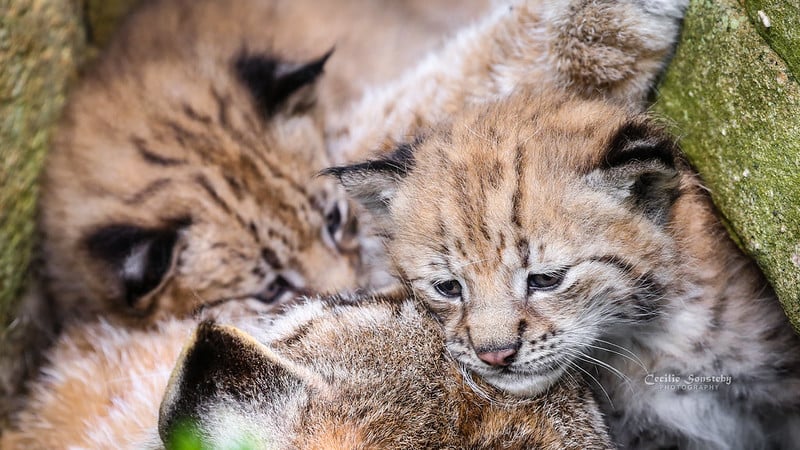CONSERVATIONISTS at the El Acebuche Iberian lynx captive breeding centre in Almonte, part of Doñana National Park, are celebrating the arrival of two new Iberian Lynx cubs – marking the fifth litter of the 2025 season.
The births, announced by the Autonomous National Parks Agency (OAPN). Previous litters, each producing three cubs, were delivered by females Madroña, Parra, Narsil, and Sardina earlier in March.
One part of the breeding centre’s excellent strategy is to tell the public the names of individual mother lynxes (and sometimes the fathers!), to stimulate interest.
This is now the fifth litter of lynxes since Madroña (a prolific mother) opened the season on Thursday, March 6. There have now been 14 lynxes born this season – three cubs in each previous litter – and Kolia and Oleander are yet to give birth.
The OAPN noted that for the latest litter the confinement of Tamesis, a first-time mother, was “unprecedented”.
Tamesis gave birth to a stillborn foetus, but “two days later, surprisingly,” she continued to have contractions, and finally, two healthy cubs were born.
For this reason, the OAPN has stated that this is “a unique case” that they will study “to better understand the species.”
READ MORE:
- Iberian lynx: How Spain brought the world’s most endangered cat back from the brink of extinction
- Spain’s Iberian lynx is no longer at risk of extinction following years of conservation efforts
- Backlash against reintroduction of Iberian Lynx in Spain
The female Madroña, who gave birth to three healthy cubs on March 6, was followed by Parra, Narsil, and Sardina, who each gave birth to three kittens.
These three births were estimated to have occurred between the 9th and 12th, as the Iberian lynx’s gestation period lasts between 63 and 65 days.
With this year’s litter, Madroña has now given birth to a total of 17 kittens over the seven breeding seasons in which she has participated, “making a very significant contribution to the recovery of her species.”
Támesis gave birth between March 12 and 13, while the last to give birth will be Kolia and Oleander, who are expected to give birth near the end of this month.
It’s worth noting that seven “genetically suitable” pairs were established for this season. Specifically, the seven pairs chosen were Hamma and Parra; Madroña and Gitano; Támesis and Juglans; Narsil and Junquillo; Oleander and Quetro; Sardina and Júpiter; and Kolia and Tintín.
According to the Autonomous Agency of National Parks, the pairs were established at the end of 2024 and were in the “socialisation phase” in December.
These pairs are chosen based on genetic information. Last December, they were in the “full pre-rut season,” and the centre’s work at that time was to socialise the selected pairs so they “would get to know and accept each other.”
This is the same number of pairs established last year, when a total of twelve lynx cubs were born.
Likewise, three cubs were also born at the La Olivilla Iberian Lynx Breeding Centre in Santa Elena (Jaén) in early March.
A spokeman for OAPN, announcing the recent births, said that the next phase in rescuing the lynx will be to cross-breed the La Olivilla and El Acebuche populations, guaranteeing variability “for greater success for the species.”
It is important for all residents of Andalucía to know that it is strictly forbidden to cause deliberate harm to a lynx: this would probably result in an immediate prison sentence for the perpetrator.
Even an accident involving lynxes, when you are driving, must be reported to the police immediately. Licence-plate recognition cameras are operating in lynx territory.
The Iberian lynx is a breed of wild cat, native to the Iberian Peninsula. It is listed as vulnerable on the IUCN Red List (IUCN = International Union for the Conservation of Nature).
In the 20th century, the Iberian lynx population had declined because of overhunting, poaching, fragmentation of suitable habitats, and the population decline of its main prey species, the European rabbit, caused by myxomatosis and rabbit haemorrhagic disease.
Fossil evidence suggests that the lynx has been present in Iberia for a million years.
By the turn of the 21st century, the Iberian lynx was on the verge of extinction. In 2002, only 94 individuals remained alive in two isolated populations in Andalucía.
Conservation measures have been implemented since then, which included improving habitat, restocking of rabbits and monitoring the lynxes.
Between 2012 and 2024, the population increased to some 2,021 individuals. This terrific success story has led to the lynx being reclassified. It is now only “vulnerable”, rather than “endangered”.








